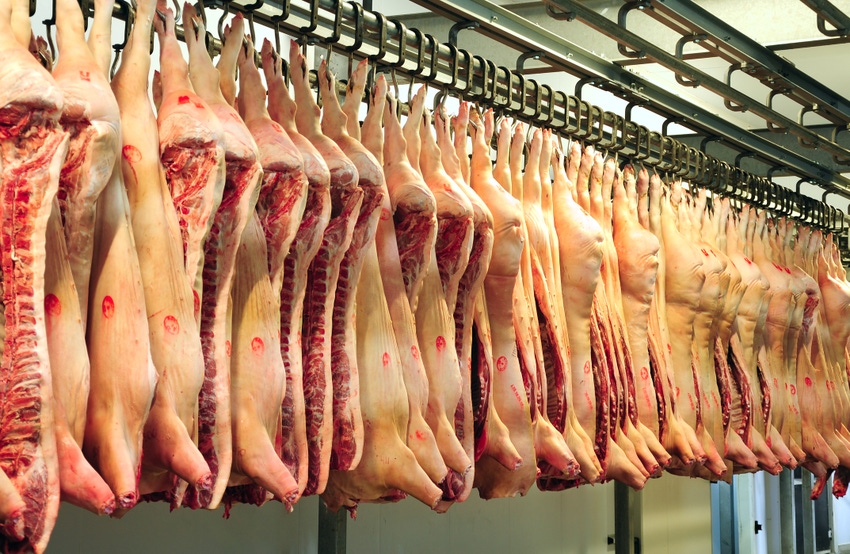Pork processing spreads widen in November
Seasonally large supplies and robust pork demand combine to yield widest spreads of the year in November.

Seasonally large supplies of slaughter hogs weighing on hog prices, along with robust pork demand pushing up product prices, combined to yield the widest pork processor spreads of the year in November, U.S. Department of Agriculture agricultural economist Mildred Haley noted in the latest “Livestock, Dairy & Poultry Outlook.”
USDA reported that the gross processor spread during November — weeks 45-48 — averaged about $68 per hog, almost 79% greater than the $38 spread of November 2018. While processors paid slightly higher prices, on average, for hogs in November of this year — the live equivalent price of 51-52% hogs averaged $42.33/cwt., 0.33% higher than last year — hog prices trended lower through November.


Haley said the circumstance that caused the spread to open up in November was strong pork demand — demand for hams in particular for export and for domestic holiday tables, plus not-insignificant demand for picnics, likely for export.
“These two cuts together contributed more than $11 of the $13 difference between the value of the wholesale carcass last month and November 2018,” she noted.
Further, Haley said gross pork processor spreads headed lower after week 46 but are likely to remain above year-ago levels for the balance of the year. The National Base Lean hog price for the first week in December averaged about 5% above 2018, while the wholesale pork cutout value in the first week of December averaged 14% above 2018.
“Large supplies of increasingly competitive pork are expected to draw export interest from Asia, which, in turn, should support the pork price component of processor spreads,” she said.
Exports to China/Hong Kong stand out
Regarding exports, Haley relayed that U.S. pork exports in November totaled 521 million lb., almost 4% higher than November of last year. Shipments to China/Hong Kong — at 101 million lb., more than triple those of a year earlier — stand out because while they were second in October volume to Mexico's 119 million lb., shipments to Mexico still were off by almost 22%.
USDA has based its forecast for the fourth quarters of 2019 and 2020 on the assumption that pork supplies in Asian countries whose herds are afflicted by African swine fever — particularly China — will continue to face significant domestic pork supply deficits.
Currently, Haley said a competitive edge remains for U.S. pork, even after accounting for Chinese retaliatory tariffs and transportation costs.
Market recap
February live cattle futures contracts were lower this week. Contracts closed lower Monday at $127.25/cwt. and Thursday at $125.625/cwt.
March feeder cattle futures were also mostly lower this week, closing lower Monday at $145.60/cwt. and Thursday at $144.825/cwt.
Beef cutout prices were lower this week. The Choice and Select cutouts closed lower Thursday at $208.99/cwt. and $200.99/cwt., respectively.
February lean hog futures contracts were mostly higher this week. Contracts closed higher Monday at $70.50/cwt. and Thursday at $70.975/cwt.
The pork cutout was lower, with the wholesale pork cutout closing at $76.71/cwt. Loins and hams were lower at $70.02/cwt. and $69.55/cwt., respectively. Bellies were lower than the prior week but finished higher at $90.18/cwt.
Hogs delivered to the western Corn Belt were higher, closing at $47.58/cwt. on Thursday.
The U.S. Department of Agriculture reported the Eastern Region whole broiler/fryer weighted average price on Dec. 13 at 85.14 cents/lb.
According to USDA, egg prices were steady, with a steady to lower undertone. Offerings were light to moderate. Supplies were light to adequate. Demand was light to fairly good.
Large eggs delivered to the Northeast were lower at $1.14-1.18, down from $1.37-1.41/doz. Prices in the Southeast and Midwest were higher at $1.18-1.21/doz. and $1.07-1.10/doz. Large eggs delivered to California were $1.71/doz.
For turkeys, USDA said the market was steady to weak, and demand was light to moderate. The price range for hens and toms fell slightly to 91 cents to $1.02/lb.
About the Author(s)
You May Also Like





